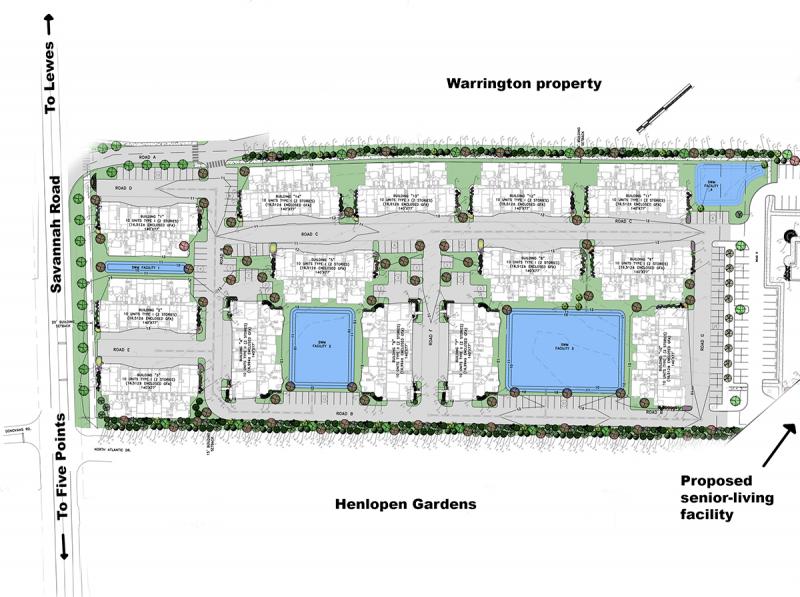If the Lewes Board of Public Works charges its full impact fee for all 140 units in the proposed Dutchman’s Harvest workforce housing project in Lewes, developer Preston Schell says they will be the most expensive fees he’s ever paid for a single project.
At $9,549 per unit, the BPW stands to collect $1.34 million.
“I’ve been doing this for 22 years now, and that is the single-highest off-site improvement cost I’ve ever been asked for in the 37 projects we’ve been involved in,” Schell said.
Schell went before the Board of Public Works Aug. 28 seeking to have the fees waived or greatly reduced. He says the impact fees as set would greatly affect the affordability of the units in his project.
BPW will hold a special meeting Tuesday, Sept. 10, to discuss Schell’s request.
Dutchman’s Harvest is in the middle of the approval process with the city. The preliminary site plan received a positive recommendation from the city’s planning commission Aug. 19, and it will soon be considered by mayor and city council.
The plan is to build 14 multi-family buildings with 10 units in each building. Of the 140 units, 42 will be sold to Diamond State Community Land Trust at direct cost; Schell ways he will not take profit from those units, including a standard developer fee. Diamond State will secure funding to purchase the units, then offer them to buyers who make 60 percent to 80 percent of the average median income of Sussex County - $68,700.
The other units will be priced 15 percent above the developer’s cost to build. All units will have strict requirements to ensure buyers are members of the local workforce.
If the BPW requires Schell pay the impact fees, he said, the affordability and appeal of his units will suffer. He says with an impact fee included, his units will be priced at or above market. In that situation, he said, a buyer could purchase a town home that offers more or less the same thing at the same price per square foot.
“If you reduce this fee, it’s not just money in my pocket, it’s money in the pockets of essentially the 140 buyers that are members of the local workforce,” he said.
Schell said his projected rate of return on his 98 units is about 9 or 10 percent. Historically, he said, he won’t consider a project that yields less than 20 percent, mainly because his bank or investors aren’t willing to take the risk.
“We’re already undertaking this project at a dramatically lower [rate of return], which I think is appropriate considering the targeted audience of these units,” he said.
The city granted a rezoning of the property for higher density because it was to be used for a workforce housing project, Schell said. By doing so, he said, the city and BPW will be getting more taxpayers and ratepayers. He said the BPW will realize much more money as a result.
“If we came in with an R-2 development and did 20 units under the original zoning and paid the $9,549 per unit, you wouldn’t get the $1.34 million,” he said.
Schell’s team analyzed how much money the BPW will receive based on monthly water and wastewater usage for an R-2 development and the proposed Dutchman’s Harvest project. He said the difference is nearly $4 million over 20 years in the 140-unit project.
“We are not asking for a free ride,” he said. “We are asking you to consider the increase in density and the payment that will be made over the next 20, 40, 100 years associated with that increased density. This will eventually reimburse and more than make up for the $1.34 million the BPW has asked us to pay upfront.”
Schell also argued the project does not require the BPW to expand its systems.
“The infrastructure we’re going to be utilizing is infrastructure in the ground now,” he said. “Whether a church is built on this site or we build 140 units, that cost the BPW incurred is done.”
BPW General Manager Darrin Gordon said impact fees are used to pay for the impact an added flow of water or wastewater will have on the utility’s infrastructure. A developer or home builder pays for the increased capacity that has to be or has been built into a system to accommodate a new customer, he said.
The BPW has regional sewer areas within its service area. The BPW’s engineer makes an educated estimate of what is likely to be built in each area and the number of people to be served. The BPW then shares the estimated costs across the total number of future customers to determine the impact fees.
Water and electric impact fees are figured the same way, Gordon said, but they are much simpler to determine, and can be shared over a greater number of future customers.
How impact fees are determined varies by jurisdiction, he said.
“There are different methodologies used across the country,” he said. “Each utility has to figure out what’s best for them. We make sure developers pay for everything they’re going to be taking advantage of.”
If the BPW is not open to waiving or reducing the impact fee, Schell said he would agree to spread the impact fee over several years and build it into the bills of the residents. It would not affect the affordability of the project now, so he could market the project as is.
The board did not make a decision on Schell’s request. They will discuss the request with staff and revisit it at a future meeting.
Nick Roth is the news editor. He has been with the Cape Gazette since 2012, previously covering town beats in Milton and Lewes. In addition to serving on the editorial board and handling page layout, Nick is responsible for the weekly Delaware History in Photographs feature and enjoys writing stories about the Cape Region’s history. Prior to the Cape Gazette, Nick worked for the Delmarva Media Group, including the Delaware Wave, Delaware Coast Press and Salisbury Daily Times. He also contributed to The News Journal. Originally from Boyertown, Pa., Nick attended Shippensburg University in central Pennsylvania, graduating in 2007 with a bachelor’s degree in journalism. He’s won several MDDC awards during his career for both writing and photography. In his free time, he enjoys golfing, going to the beach with his family and cheering for Philadelphia sports teams.

























































